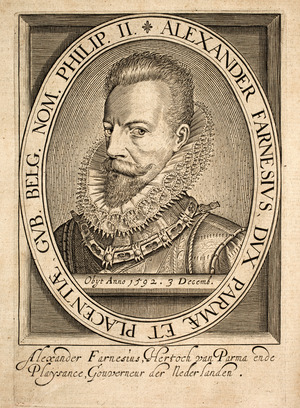Capture of Geertruidenberg (1589) facts for kids
Quick facts for kids Capture of Geertruidenberg (1589) |
|||||||
|---|---|---|---|---|---|---|---|
| Part of the Eighty Years' War and the Anglo-Spanish War (1585–1604) | |||||||
|
|||||||
| Belligerents | |||||||
| Commanders and leaders | |||||||
The Capture of Geertruidenberg in 1589 was an important event during a long war. It happened on April 10, 1589, in a place called Geertruidenberg. This area is now part of the Netherlands. This event was part of two big conflicts: the Eighty Years' War and the Anglo-Spanish War (1585–1604). Sometimes, people called it the English betrayal of Geertruidenberg.
What Happened at Geertruidenberg?
On April 10, 1589, the city of Geertruidenberg was taken over. The soldiers defending the city were mostly English and some Dutch troops. Their leader was Governor Sir John Wingfield.
They surrendered the city to the Army of Flanders. This was the Spanish army, led by Don Alexander Farnese. He was the top Spanish leader in the Spanish Netherlands.
Why Did the City Surrender?
Just a few days before the surrender, the English soldiers had a problem. They did not get their pay on time. Because of this, the soldiers refused to obey orders. This is called a mutiny.
There were rumors that Governor Wingfield planned to give the city to the Spanish. The Dutch government, called the States-General, and Prince Maurice of Nassau accused him of betraying them.
Wingfield said he did not betray anyone. But the result was clear: Geertruidenberg was now controlled by the Spanish.

Later Events
In September of the same year, the Spanish leader Parma sent his army. They went to attack another city called Rheinberg. The soldiers defending Rheinberg gave up in February 1590.
Geertruidenberg was later taken back in June 1593. This time, an army of English and Dutch soldiers worked together. They were led by Maurice of Nassau and Francis Vere.
See Also

